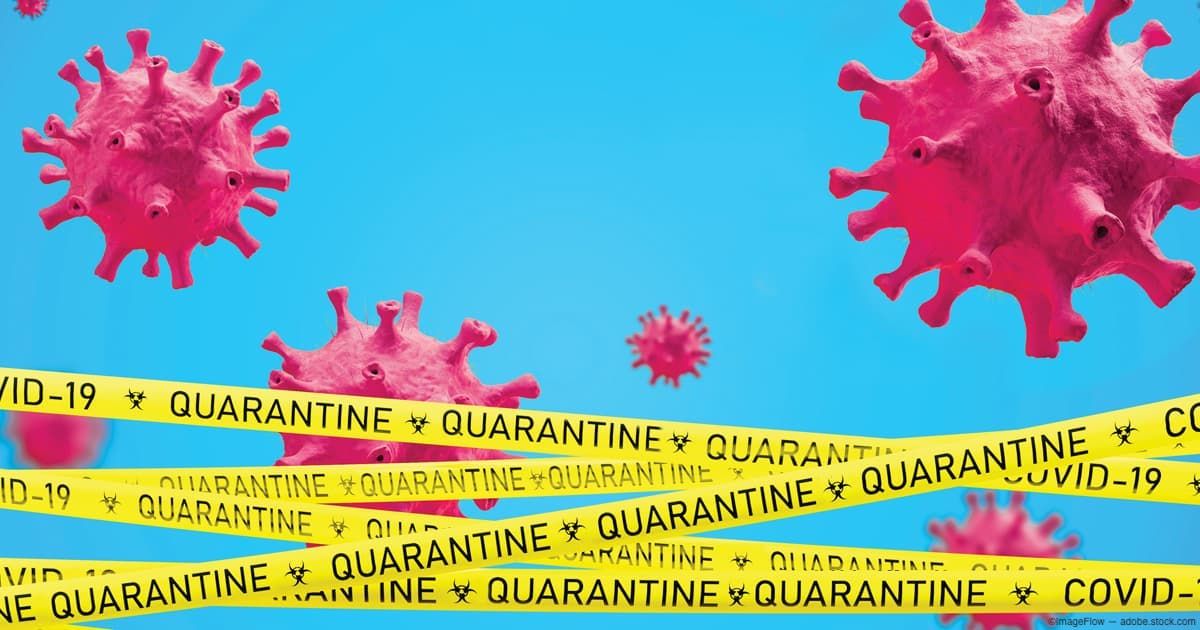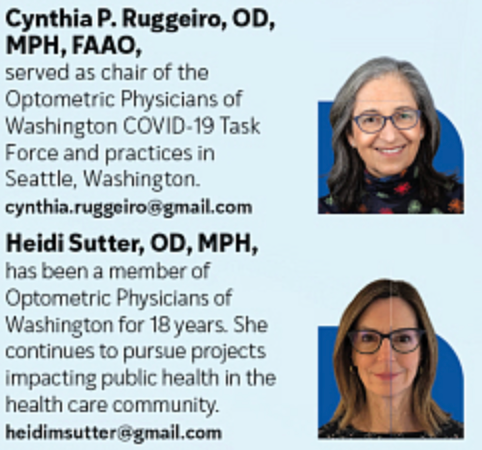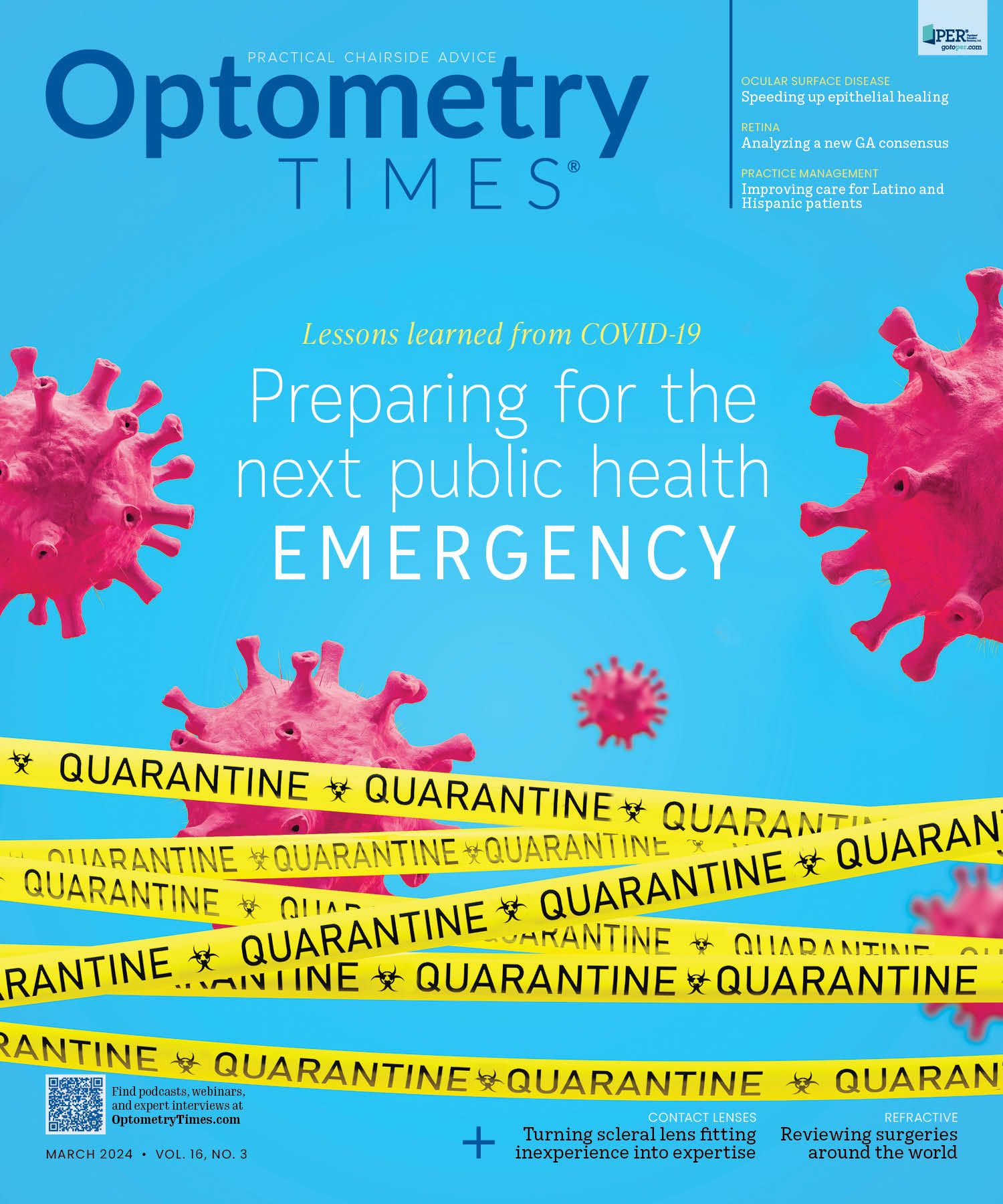Lessons learned from COVID-19: How to prepare for the next public health emergency
How eye care practices and doctors can prepare for the next pandemic
Image Credit: AdobeStock/ImageFlow

Since its emergence in late 2019, the SARS-CoV-2 virus has changed lives and livelihoods and raised our awareness of the potential for circulating pathogens to disrupt our world. Although COVID-19 is still with us, we are removed enough from the early days of widespread uncertainty to start assessing what we have learned.
We share here lessons learned from our experience in Washington state, which was hit very early in the COVID-19 pandemic. To assist our colleagues in navigating new challenges, members of Optometric Physicians of Washington (OPW), an affiliate of the American Optometric Association (AOA), formed a COVID-19 task force. The volunteer group included optometrists and optometric association staff with experience in public health, business administration, interprofessional relations, and community outreach. This breadth of backgrounds allowed the group to quickly identify issues unique to optometry and make cogent recommendations. Here are our takeaways from that experience.
Providing urgent/emergent care when nonurgent care was suspended
Early in the pandemic, the Centers for Disease Control and Prevention (CDC) identified eye care and dental care as professions potentially at higher risk. When Washington state’s governor suspended nonurgent eye care, the focus shifted to preserving patients’ safe access to urgent and emergency care. We created a directory of hospital-based providers as well as those with access to personal protective equipment (PPE) who were equipped to handle patients with COVID-19 with urgent eye needs. To tackle PPE shortages, we leveraged connections to an out-of-state source for supplies and sold them to our members at cost. OPW also participated in a statewide PPE exchange for health care professionals to source bulk PPE at reduced prices. We encouraged optometrists to limit patient time in office by utilizing telemedicine and drive-by optical dispensing.
Communication and support
Early on, providing useful validated information was crucial. The task force created a periodic open-access digest of vetted information on COVID-19 viral transmission, infection control, and indoor air quality, among other topics. The digest also kept readers informed on state and county pandemic proclamations.
Isolation and disorientation from the shutdown took a toll on the personal and emotional lives of providers. OPW recognized this and held several webinars and virtual town halls hosted by clinical psychologists addressing mental health and well-being. Technical assistance with videoconferencing was shared with local societies to continue meetings and much-needed interaction among members.
Financial concerns
Keeping practices and OPW financially viable was crucial. OPW offered webinars hosted by experts on government assistance programs and employment law. Organization dues were suspended. Help Optometric Physicians in an Emergency (HOPE), a loan program for practitioners having financial difficulties, was financed using organization assets. Fill the Bank, a program to monetize member-created continuing education (CE) content also was created. As of the end of 2022, 80% of the HOPE loans had been repaid. With these creative solutions, OPW avoided bankruptcy while supporting the optometric community.
Preparing for return to care
The task force members recognized that when the nonurgent care restriction was lifted, optometrists would need guidance on the safest way to continue patient care while reducing the potential for exposure and transmission of the virus among patients. A “Return to Nonurgent Care Practice Protocol” was created by the task force, using the best available guidance from vetted sources such as the CDC, AOA, and the American Academy of Ophthalmology. Topics included best practices for reconfiguring offices and schedules to support social distancing, implementing screening procedures for staff and patients, establishing policies for employee sick leave, establishing protocols for PPE use and disinfection, reporting cases to local public health authorities, and safe optical dispensing. This document was made available to all optometrists in the state.
State influence
Task force members were invited to join several governor-level and state Department of Health COVID-19 working groups. This collaboration with state decision makers allowed task force members to advocate for the needs of smaller, office-based professions as the rules for returning to nonurgent health care were being defined. OPW’s participation in these working groups elevated optometry’s status as an important part of the state’s health care landscape and opened a clear line of communication to the governor’s office and the state Department of Health leadership.
Lessons learned
In 2023, the World Health Organization launched the Preparedness and Resilience for Emerging Threats Initiative,1 which offers a useful template to learn from our past and prepare for the future. This call to action emphasized 3 themes, as follows1:
- Update preparedness plans that learn from experience and anticipate future respiratory pathogen pandemics.
- Increase connectivity among stakeholders in pandemic planning.
- Dedicate investments in preparations that address gaps identified in the past.
Looking back at our experience, we learned several key lessons.
Professional health associations (PHAs) such as OPW played an important role during the pandemic.2 Their existing infrastructure provided economies of scale in purchasing and crucial administrative support during emergencies. PHAs fostered communication among colleagues, allied professionals, and policy makers. Establishing connections to professionals in other disciplines and state health agencies was crucial during the pandemic to access information quickly and share concerns unique to optometry. We also found that adding a public health focus to the mission of our optometric association allowed a quick pivot to address needs during the pandemic.
Optometrists have a responsibility to maintain much-needed eye and vision care during emergencies. Because of connections made at the state level, the task force was able to advocate for maintaining this access, especially for first responders and medically vulnerable patients.We benefited from having a working relationship with the executive branch as well as the legislative branch of state government.
State optometric boards that modified CE requirements, such as accepting remote CE, allowed optometric education to continue safely without penalizing practitioners at risk for infectious disease.
Advocating for our profession during the pandemic revealed diverse opinions about the way forward. We must acknowledge the differing attitudes toward the role of government, personal assessment of risk, and past negative experiences with the health care system. This diversity of opinion greatly impacted the acceptance of public health messaging.
How can you prepare for the next pandemic?

Unfortunately, COVID-19 probably won’t be our last pandemic. We have compiled a list of what you can do now to prepare, as follows:
- Improve indoor air quality. We learned much about the aerosol transmission of SARS-CoV-2 during the pandemic.3 We have the tools to reduce airborne illness by improving indoor air quality. This includes using portable HEPA filters in clinics or, when possible, using MERV-13 filters in existing heating, ventilation, and air conditioning systems.4-6
- Stay up-to-date with protocols to reduce infectious disease, including vaccination and masking. Maintain recommended disinfection of surfaces, patient contact points, contact lenses, diagnostic lenses, and equipment.7,8
- Improve guidelines for handling staff illnesses, including policies for sick leave and remote work. Offer testing for infectious diseases. Educate yourself about your state’s labor laws.
- Analyze inventory management. Coordinate with colleagues on potential sources of supplies in times of shortages. Offer a surplus of supplies to underserved areas or clinics.8
- Support your professional organizations by volunteering, especially if you have special skills useful in emergencies.
- When possible, embrace the use of telemedicine for vulnerable populations.
- Most importantly, assess your own clinical experience. What went well? What aspect could have been handled differently? An audit of your practices during the pandemic will reveal what could help you in the next one.
References:
Preparedness and resilience for emerging threats. World Health Organization. Accessed November 15, 2023. https://www.who.int/initiatives/preparedness-and-resilience-for-emerging-threats
Farmer D, Pascual J, Kaplan LJ. COVID-19 and the role of medical professional societies. COVID-19 Pandemic. Elsevier; 2022;99-107. https://www.sciencedirect.com/science/article/pii/B9780323828604000100
Tang S, Mao Y, Jones RM, et al. Aerosol transmission of SARS-CoV-2? evidence, prevention and control. Environ Int. 2020;144:106039. doi:10.1016/j.envint.2020.106039
Morawska L, Allen J, Bahnfleth W, et al. A paradigm shift to combat indoor respiratory infection.Science. 2021;372(6543):689-691. doi:10.1126/science.abg2025
Improving ventilation in buildings. CDC. Updated May 11, 2023. Accessed November 15, 2023. https://www.cdc.gov/coronavirus/2019-ncov/prevent-getting-sick/improving-ventilation-in-buildings.html
Safe work, safe school, and safe travel. The Lancet. Accessed November 15, 2023. https://covid19commission.org/safe-work-travel
Viana Martins CP, Xavier CSF, Cobrado L. Disinfection methods against SARS-CoV-2: a systematic review. J Hosp Infect. 2022;119:84-117. doi:10.1016/j.jhin.2021.07.014
Yasir M, Vijay AK, Willcox M. Antiviral effect of multipurpose contact lens disinfecting solutions against coronavirus. Cont Lens Anterior Eye. 2022;45(5):101513. doi:10.1016/j.clae.2021.101513
Hom G, Chous AP. The prospect of pandemic influenza: why should the optometrist be concerned about a public health problem? Optometry. 2007;78(12):629-643. doi:10.1016/j.optm.2007.04.099
